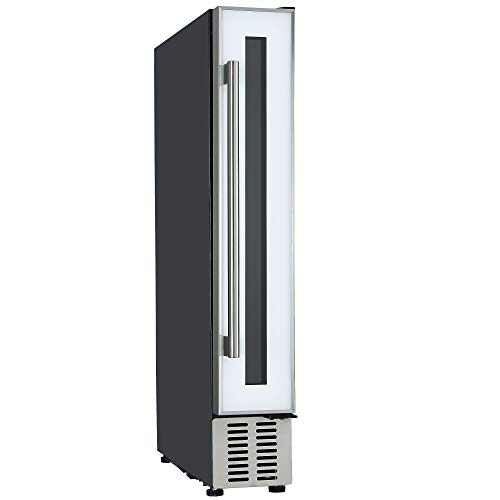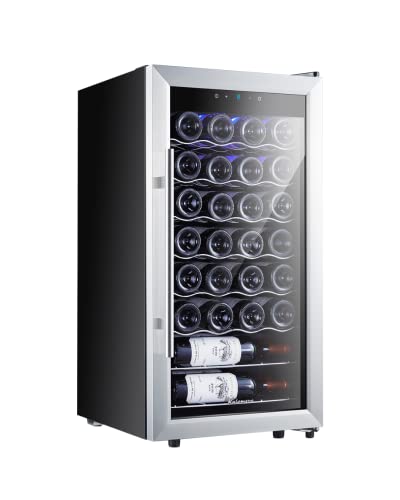You'll Never Guess This Wine Refrigerator Built In's Benefits
페이지 정보
작성자 Rodolfo 작성일 25-01-20 02:39 조회 27 댓글 0본문
 Energy Efficient Wine Storage With a Wine Refrigerator Built in
Energy Efficient Wine Storage With a Wine Refrigerator Built inThis energy-efficient built-in wine refrigerator allows you to store and serve your wine at the perfect temperature. Dual temperature control zones allow you to keep white and red wines separately to preserve their full flavors.
 These units are designed to seamlessly blend into your cabinetry and can be positioned beneath countertops to allow easy access to a refreshing Riesling glass after dinner. They require adequate ventilation and clearance to dissipate the heat.
These units are designed to seamlessly blend into your cabinetry and can be positioned beneath countertops to allow easy access to a refreshing Riesling glass after dinner. They require adequate ventilation and clearance to dissipate the heat.Capacity and Size
Built-in wine refrigerators offer an elegant and sleek alternative to the bulky freestanding units. These wine chiller coolers are constructed with front vents that can be hidden in cabinets or under counters for a seamless appearance. These wine coolers are more versatile, allowing for the storage of cold beverages as well as wine.
With capacities up to 368 bottles, these wine refrigerators are designed to accommodate serious collectors with substantial collections. They are designed to protect your wine for a long period of time by ensuring that they have ample storage space as well as precise climate control. These units are perfect for garages, basements or areas that are not conditioned and where a more robust and sturdy storage environment is needed.
The cooling capacity of a wine fridge is typically measured in terms of the number of standard Bordeaux-style bottles it can hold. It is also important to consider whether your collection includes other sizes of bottles, such as Champagne or Burgundy. This will affect your capacity requirements, as these bottles require more space than the Bordeaux standard bottle. Some wine refrigerators come with adjustable shelves that allow for storing different sizes of bottles.
In addition to the size of your wine fridge, you'll need to think about where to place it. If you're planning to install it into existing cabinets, it's important to remember that you'll require adequate clearance on the left and right sides of the unit as well as 6 inches of clearance at the back. This allows the heat created by the wine refrigerator to escape and prevent overheating.
You should think about the possibility of adding one of these high end wine fridges in your kitchen if you're planning to spend a fortune on an expensive model with an impressive stainless-looking finish. These models will bring a touch of luxury to your home thanks to their sleek and elegant door designs. These refrigerators are also available in larger sizes and are perfect for those who enjoy entertaining and large gatherings. These wine refrigerators come with various features, including dual-zone cooling, UV protection and numerous other options.
Ventilation
If a wine refrigerator is not properly ventilated hot air can accumulate and cause the appliance to overheat. Ventilation is important because it allows the cooler to maintain a consistent humidity and temperature while also ensuring against fluctuations in temperature which could harm the bottles or alter the taste of the wine. Check your wine refrigerator after it has been running for a short time to make sure it has the correct ventilation system. If the fridge is cool to the touch, then it is ventilated properly.
Most wine refrigerators have an internal sensor that monitors temperature and alerts you when it is out of range. Some models have dual temperature-controlled zones to allow you to store different types of wines at ideal serving temperatures.
The ideal temperature for storing wine is between 55 and 66 degrees Fahrenheit. This will prevent cork mold and other issues that could damage your collection. Some models even include a light indicator that illuminates when the temperature inside is below your desired setting.
Depending on your storage needs depending on your needs for storage, a built-in wine refrigerator can be the ideal solution to store your entire collection. They can be placed under counter wine fridge counters in the bar or kitchen to allow guests to access. Some models feature front vents, so they can be installed flush with your cabinetry to create an elegant appearance.
To install a wine refrigerator, you need to carefully measure the designated space and account for the cabinet's width. The fridge must be at least a few inches away from the wall on all sides to allow adequate ventilation. A wine fridge that is pushed against a wall or cabinet can block the vents, blocking heat from escaping. Freestanding commercial wine refrigerator refrigerators have vents on the side or rear to efficiently disperse heat.
Installation
A wine refrigerator that is built-in can make a chic, functional bar to your home. But, there are a few things to consider when deciding the ideal spot for your new appliance.
First and foremost, ensure that your new cooler has enough space to allow for adequate ventilation. If the wine refrigerator isn't properly ventilated, it will overheat and ultimately reduce its lifespan.
In addition, you should keep your wine fridge clear of direct sunlight or other heat sources. This will protect your collection from the damaging ultraviolet rays from the sun, and will also allow it to cool faster.
Also, make sure that your wine refrigerator is not too close to a heat-producing appliance like dishwashers. This could cause your wine to be damaged or experience unpredictable temperature fluctuations.
Wine refrigerators come in two different types including freestanding and built-in. While freestanding wine refrigerators are more flexible in terms of how they can be installed, built-in units offer a seamless integration into kitchen cabinetry. Both are available in different sizes and styles so you can pick one that will fit your needs.
You should measure the area where you intend to place your wine refrigerator to ensure that it is able to properly ventilate. If possible, try to leave some inches of space around the unit for ventilation purposes. Make sure that the door can open completely. If it's not open, the racks inside are difficult to reach.
Certain models could also have specific temperature preferences. Certain wine refrigerators can store red wines at 55 degrees Fahrenheit to ensure optimal serving, while others are only suitable for long-term storage. You may want to invest in a dual zone wine refrigerator depending on your needs. This will allow you to keep long-term wines chilled and serve chilled drinks in another zone.
If you're planning to install a wine refrigerator built in it, make sure you've follow the manufacturer's guidelines carefully to ensure that your new cooler is properly installed. Wait a few hours after putting it into the room before turning it on to allow the coolant to settle.
Energy Efficiency
In a time when energy is costly It is crucial to take into consideration the energy consumption of appliances. When purchasing a built-in wine fridge be sure to look for models that have an Energy Star rating or certification. This means that the wine refrigerator is constructed using the most advanced cooling technology and insulation to conserve energy.
A wine refrigerator has to cool the entire interior, as well as the bottles that are kept within. A larger wine fridge with a larger capacity for bottles will use more energy than a small model. The ambient temperature in the room can also affect the power consumption of the fridge because it must work harder to maintain the temperature of the interior.
If you want to reduce the energy consumption of your wine refrigerator ensure that it is fully stocked. This may seem counterintuitive, but a wine fridge that is filled with cold, sealed bottles won't have to struggle as much to maintain its internal temperature. Also, having the shelves and bottles set correctly can also help your wine fridge to run more efficiently. For example, arranging your bottles horizontally will allow them to chill more quickly than if they're arranged upright.
A new model with advanced cooling technology can help you cut down on the energy consumption of your wine fridge. The latest models are more energy efficient than older models and can save you as much as PS100 per year on energy costs.
Choose a wine refrigerator that has a low-energy cooling compressor system when shopping. This type of fridge consumes less energy and is also more environmentally green than a wine fridge with a higher-energy compressor system. Consider a thermoelectric fridge. These wine coolers make use of the Peltier effect to cool the interior of the fridge. They use much less energy than compressor-based units. However they are more sensitive to ambient temperatures and require some maintenance. Look for a brand with an established reputation for making top-quality, reliable wine refrigerators. They're likely to make fridges that have an energy efficient cooling system and a quiet operation.
댓글목록 0
등록된 댓글이 없습니다.
